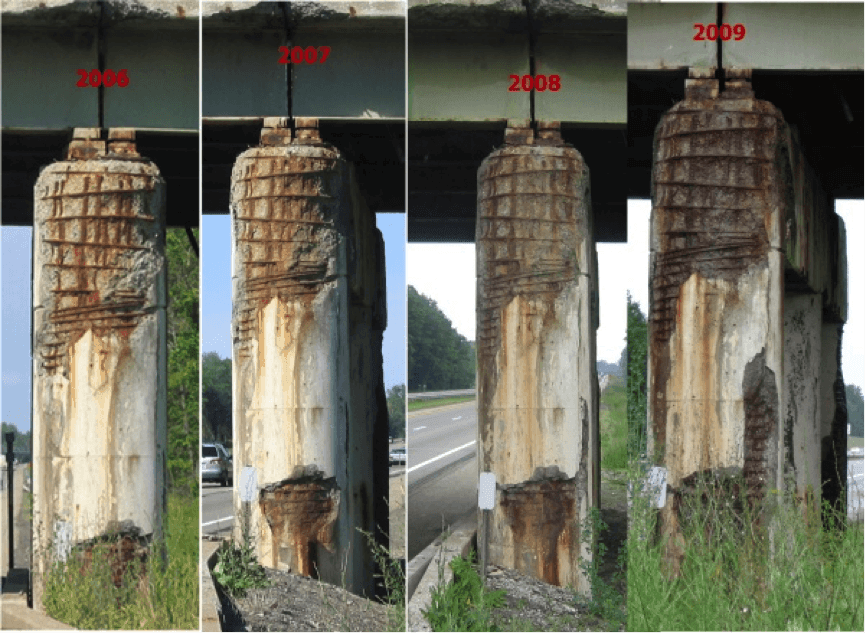In construction, concrete is a popular and reliable material because of its durability. While it is resilient to wear and tear, it is not immune to damage. Like any material, it can succumb to physical and chemical stresses. Below are some of the most common types of concrete damage that a structure may experience over time:
- Water Damage– One of the most common causes of concrete damage is water infiltration. Water can permeate through concrete over time due to cracks or other weak points in the construction. When moisture seeps through, it can weaken the structure and cause erosion. This can lead to cracking, buckling, and other structural issues. It is important to seal any cracks or weak points in order to protect the concrete from water damage.
- Chemical Damage– Certain chemicals can also cause damage to concrete structures. This includes chlorides, acids, alkalis, oils, and fuels. When exposed to these substances, the concrete can become weakened and may experience spalling, cracking, or discoloration. It is important to protect the surface of the concrete from chemical spills and contact with corrosive materials.
- Fire Damage– Fire can also cause damage to concrete structures. The intense heat can weaken the structure and cause cracks to form. Additionally, the smoke produced can leave behind residue that can weaken the surface of the concrete. It is important to have fire-resistant materials in place and properly maintain your structure in order to protect it from fire damage.
- Impact Damage– Impact damage can occur when a heavy object or force strikes a concrete structure. This often results in cracking, chipping, or spalling of the concrete. Additionally, the impact can cause vibration that can weaken the structure over time. It is important to protect your concrete from potential impacts in order to avoid damage.
Concrete is a durable material when used in construction, but it is not immune to damage. Water, chemicals, fire, and impact can all cause significant issues for concrete structures. It is important to be aware of these potential issues, take steps to protect the structure from damage, or repair concrete if it has already been affected.
How to prevent concrete damage
For optimal protection, there are a few steps you can take to prevent concrete damage. Here are some tips:
- Seal any cracks or weak points in order to prevent water damage– This includes sealing any joints or openings in the structure to prevent water infiltration.
- Install a protective coating on the surface of the concrete– This will help protect it from chemical damage and other abrasive materials. If the coating begins to wear away, reapply it as soon as possible.
- Place fire-resistant materials around the structure– This will help protect it from potential fire damage. Some materials to use include concrete, metal, or stone.
- Protect the structure from impacts– This includes placing heavy objects away from the structure, as well as installing padding around any sharp edges that could cause damage. When possible, it is also a good idea to set up buffers between the structure and heavy objects.
Following these steps can help you protect your concrete structure from damage. While it is not immune to all potential issues, taking these preventative measures will help ensure that your structure remains safe and intact for years to come.
What are the consequences of not preventing concrete damage?
If concrete damage is not prevented, it can have serious consequences. Here are a few of the issues that can arise:
- Structural failure– Water damage, chemical damage, fire damage, and impact damage can all cause concrete to weaken over time, potentially leading to structural failure. This can be dangerous and expensive to repair.
- Loss of aesthetic appeal– Damage such as cracking and discoloration can make concrete structures less appealing and decrease the value of your property.
- Loss of functionality– In some cases, concrete damage can render a structure unsafe to use, or unusable altogether.
For these reasons, it is important to take steps to prevent concrete damage before it becomes an issue. With proper care and maintenance, concrete can retain its strength and functionality for many years.
By taking the necessary steps to prevent concrete damage, you can protect your structures and ensure that they remain strong, safe, and aesthetically pleasing for years to come. With the right knowledge and tools, a concrete repair can be handled quickly and easily – allowing you to get back to enjoying your concrete structures as soon as possible.
